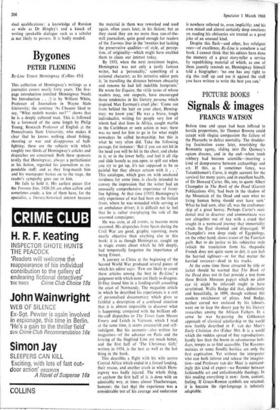Bygones
PETER FLEMING
By-Line Ernest Hemingway (Collins 45s) This collection of Hemingway's writings as a journalist covers nearly forty years. The five- page introduction (entitled 'Hemingway Needs No Introduction . . .') is by William White, Professor of Journalism in Wayne State University; the sentence 'As Chaucer liked to say, "What nedeth wordes mo?" ' shows that he is a deeply cultured man. This is followed by a foreword of the same length by Philip Young, Research Professor of English at the Pennsylvania State University, who makes it clear that he knows nothing about fishing, shooting or war and disapproves of bull- fighting; these are the subjects with which roughly two thirds of Hemingway's articles and dispatches are concerned. Both these sponsors testify that Hemingway, always a perfectionist in his fiction, regarded his journalism as ex- pendable stuff; and as they frog-march him and his wastepaper basket on to the stage, the reader's sympathy goes out to him.
He fails to hold it. His earliest pieces (for the Toronto Star, 1920-24) are often callow and sometimes crude; a few of them have, for the specialist, a literary-historical interest because the material in them was reworked and used again, often years later, in his fiction; but as they stand they are no more than run-of-the- mill journalism, quite good enough for readers of the Toronto Star in the 'twenties but lacking
the preservative qualities—of style, of percep- tion, of originality—which might have enabled them to claim our interest today.
By 1933, when the next instalment begins, Hemingway was not only a justly famous writer, but a 'personality,' something of a national character; as his intrusive editor puts it, 'in travelling the distance between obscurity and renown he had left indelible footprints.'
He wrote for Esquire, the virile tastes of whose readers may, one suspects, have encouraged those tendencies in his literary persona which inspired Max Eastman's cruel jibe: 'Come out from behind the hair on your chest, Heming- way; we know you.' He was a brave, tough individualist, writing for people very few of whom had shot lions in Africa, caught marlin in the Caribbean or seen action in war; there was no need for him to go in for what might nowadays be called he-manship, but this is what he very often did. Take the following passage, for instance: 'But if you are not hit in the head you will be hit in the chest, and choke in it, or in the lower belly, and feel it all slip and slide loosely as you open, to spill out when you try to get up, it's not supposed to be so painful but they always scream with it . .
This catalogue, which goes on with unabated vividness for some time, is clearly intended to convey the impression that the writer had an unusually comprehensive experience of front- line fighting. At that time (1935) Hemingway's only experience of war had been on the Italian front, where he was wounded while serving as an ambulance driver; it is difficult not to feel that he is rather overplaying the role of the seasoned campaigner.
He was soon, at all events, to become more seasoned. His dispatches from Spain during the Civil War are good, graphic reporting, more nearly objective than anything else in this book; it is as though Hemingway, caught up in tragic events about which he felt deeply, had temporarily forgotten the importance of being Ernest.
A journey to China at the beginning of the Second World War produced several pieces of which his editor says: 'Few are likely to count these articles among the best in By-Line,' a judgment with which none are likely to disagree.
D-Day found him in a landing-craft assaulting the coast of Normandy. The magazine article in which he described his experiences is a sort of personalised documentary which gives so faithful a description of a confused situation that it is almost impossible to discover what is happening; compared with the brilliant off- the-cuff dispatches to The Times from Messrs Emery and Leitch in Vietnam, which I read at the same time, it seems amateurish and self- indulgent. But his accounts—also written for magazines—of the advance on Paris and the forcing of the Siegfried Line are much better, and the first half of 'The Christmas Gift,' written in 1954, is the best as well as the last thing in the book.
This descritks a flight with his wife across Central Africa which ended in a forced landing,
their rescue, and another crash in which Hem- ingway was badly injured. The whole thing, or anyhow the first half of it, is done with an admirably wry, at times almost Thurberesque, hUmour; the fact that the experience was a considerable test of his courage and endurance
is nowhere referred to, even implicitly; and his own mixed and almost certainly deep emotions on reading his obituaries are treated as a good joke of an unusual kind.
Despite this flash—and other, less refulgent ones—of excellence, By-Line is somehow a sad book. I cannot think that his editors have done the memory of a great story-teller a service by republishing material of which, as one of them jauntily reminds us, Hemingway himself told a biographer: "no one has any right to dig this stuff up and use it against the stuff you have written to write the best you can.'


































 Previous page
Previous page